Are you tired of losing your potato crop to blight? The waste of time and money can be devastating, so learning how to avoid potato blight damage is critical.
The best way to grow a healthy crop of potatoes is to know what potatoes are blight resistant, which I highlight in this guide. I also discuss how to spot blight and ways you can prevent it from creeping into your garden.
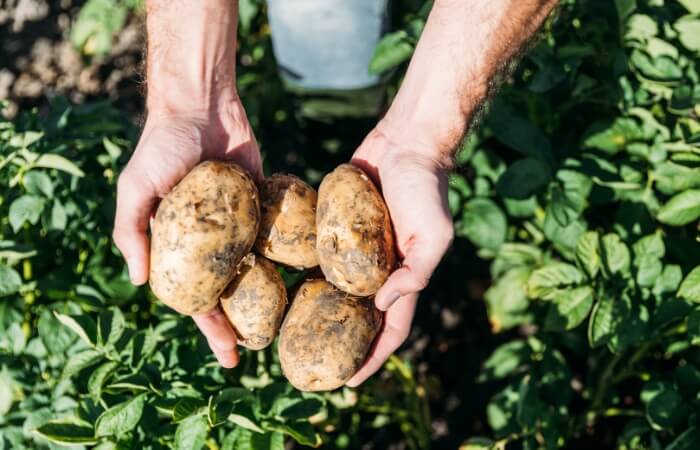
Potato blight can be a thing of the past when you know which potato varieties to plant, so check out this list and start planning your next crop now!
What Is Potato Blight?
Potato blight is a destructive disease caused by the spores of Phytophthora infestans fungus. Blight spores can travel through the air to infect soils miles away and lie dormant in the soil through winter between crop plantings.
The microscopic spores can also hide out on potatoes you store for use as seed the following season, which will quickly infect the soil where you plant them.
Potato blight fungus comes to life during warm and wet conditions and rapidly spreads from the leaves into the soil during rain or watering.
Once in the ground, the fungus will feed off the tubers, often ruining the entire crop.
Late Blight Symptoms
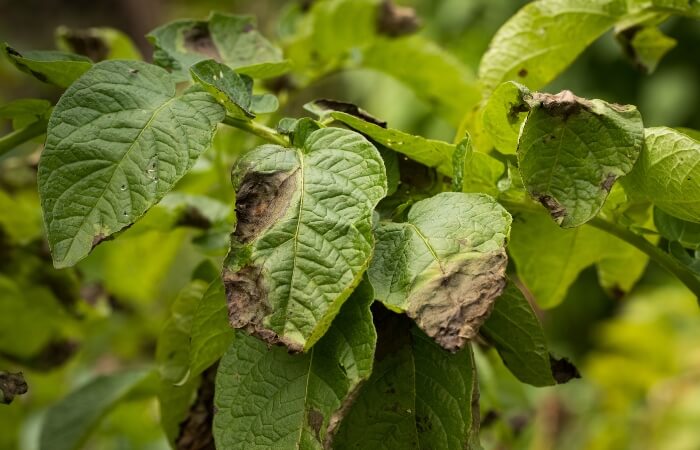
Spotting late blight on your potatoes isn’t difficult. First, look for dark brown circular patches on the foliage that appears to be spreading.
Next, the leaves will start to shrivel and become black, while the stems get brown spots. After this stage, the entire plant will wilt and rot away.
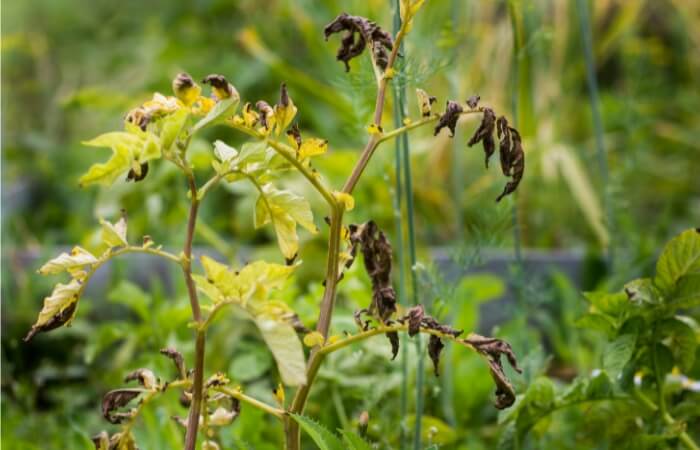
Blight symptoms on tubers include:
- Dark brown or black spots on the skin and underlying flesh
- Sunken areas on the potato surface
- Reddish-brown flesh under the skin that moves into the center of the spud
- Squishy or soft tubers
- Foul smell where rot has set in
- Healthy-looking spuds rotting quickly in storage
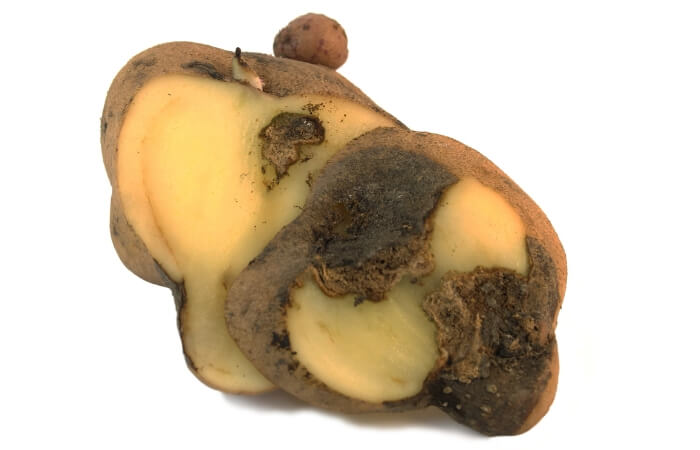
Can You Prevent Potato Blight?
Because blight spores easily move through the air and water, it’s impossible to totally prevent blight from affecting your potato crops.
However, you can mitigate blight damage by following these rules:
- Always rotate potato crops in your garden plots
- Always use new seed potatoes from reputable suppliers
- Plant blight-resistant potato varieties
- Early-season potatoes have less chance of blight versus late-season crops
- Water potato plants around the base early in the day (avoid wetting foliage)
- Mounding potato rows is better than planting in flat ground to deter excessive moisture around the tubers
- Trim away and burn any blight-stricken foliage immediately
- Monitor potatoes in storage for signs of rot and remove infected tubers
Of all the above suggestions, choosing certified seed potatoes from blight-resistant varieties and rotating crops are the two most beneficial ways to combat blight in your garden beds.
In addition, experts suggest three to four years of gap between potato plantings in the same garden area.
Moving your potatoes to grow bags or other containers is another great way to corral any potential blight infections instead of risking passing them into your main garden plots.
Be aware that blight resistance does not mean blight eradication. All types of potatoes and other Solanaceae, or nightshade, vegetables can harbor fungal spores.
Tilling in any crop residues from these plants will give blight an easy path to destroy any potatoes you plant in this soil.
Why Choose Blight Resistant Potatoes?
Blight-resistant potatoes are specially-bred specimens that have a more robust defense against the Phytophthora infestans and Alternaria solani fungus that causes late and early blight.
Potato crops unaffected by blight will provide a more abundant harvest of fully mature tubers that remain in good condition longer during storage.
Using potatoes resistant to blight can help gardeners struggling to produce viable crops. In addition, some varieties can suffer blight damage on the foliage with little to no damage to tubers, which means more food in your pantry.
Less blight in your garden also helps nearby crops from infestation because fewer spores will be airborne and spread.
Switching to blight-resistant potatoes is a great way to increase crop yields while maintaining a healthy gardening system, so future growing seasons are also successful.
Best Blight Resistant Potato Varieties
Help your garden succeed by choosing these blight-resistant potato varieties for spring or fall plantings:
Setanta

The Setanta potato has red skin and yellow, slightly sweet, and nutty flesh, perfect for baking, fries, chips, and roasting.
In addition, the Setanta has a high tolerance against blight and scabs, even when left in the ground after the crop matures, making it especially ideal for organic gardens.
Time to Maturity: 126-140 days
Sarpo Blue Danube
The Sarpo Blue Danube has stunning purple skin and dry white flesh, making them ideal for roasting or baking.
The Danube can be planted early, mid, or late season and, when stored properly, will not sprout or soften as early as other potato types.
Time to Maturity: 100 days
Cara
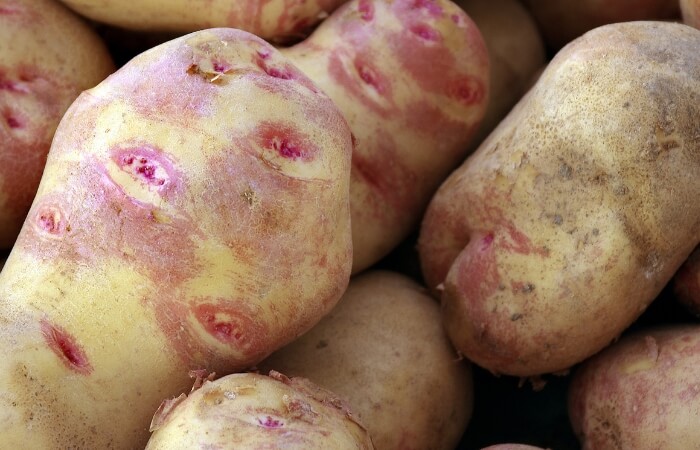
Cara is a great potato for mashing or baking, but the smooth yellow and pink eyed skin and white, sweet flesh has a waxy texture that works well in all dishes. Cara resists all types of common potato diseases and produces a bountiful crop. The potato is excellent for light soils and stores well.
Time to Maturity: 140-156 days
Nicola
Nicola is another high-yield variety that boasts a large oval shape, with yellow skin and flesh.
The flavor is buttery and is a tasty addition to potato salads and soups when boiled and diced. However, the waxy texture is suitable for all kinds of cooking methods.
Days to Maturity: 105-119 days
Robinta
Robinta potatoes are Alaskan-bred and very tolerant against blight. The medium-size tuber has red skin with yellow flesh. The Robinta makes creamy mashed potatoes or deliciously soft baked potatoes. This variety is known to handle both drought and rainy conditions well.
Days to Maturity: 120 days
Molly Magic

Molly Magic is a colorful purple potato from the skin through the flesh. You can enjoy these as new potatoes and leave some to fully mature.
Excellent for roasting or frying, as the dense flesh maintains texture under heat. The spud has an earthy flavor with low starch content.
Days to Maturity: 110 days
Acoustic
Acoustic potatoes are a heavy-yield variety with excellent blight resistance. Early harvests will produce a waxier spud best for boiling or salads.
As the potato matures, the flesh turns dryer and fluffier, making them best for mashing or baking.
The potatoes are round, with pale yellow skin and flesh, with a bright, rich flavor. Acoustics grow well in all soil types, even heavy clay.
Days to Maturity: 98-112 days
In Summary
Potato blight is a real nuisance that can ruin the best-laid gardening plans. Luckily, scientists and garden experts have bred potato varieties to withstand the harmful effects blight fungus causes.
When you have a choice, always select blight-resistant seed potato varieties like the ones I list above to give yourself a favorable headstart on your early, mid, or late-season potato crops.
Between a blight-tolerant variety and good gardening practices, you’ll reach the goal of harvesting mounds of plump, healthy potatoes you can enjoy for months to come!










